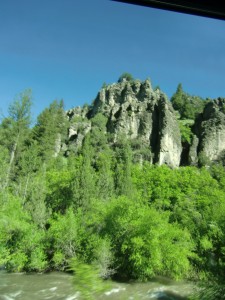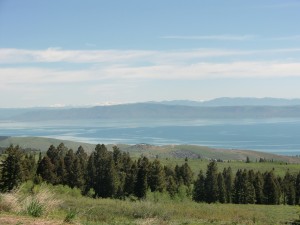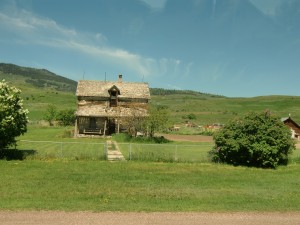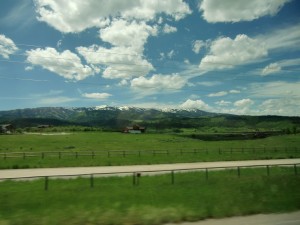THE BEST OF THE WEST – NORTH TO YELLOWSTONE (PART 1)
THE BEST OF THE WEST
This is the fifth in a series of articles about traveling the West by bus.
NORTH TO YELLOWSTONE (PART 1)
By Charles N. Stevens
Photos by Dolores Seidman
The day promises to be clear and hot, but we’re traveling much farther north today where
the temperature should be cooler. Once on Interstate 15 again, we head toward the northern outskirts of Salt Lake City, an area of industry, refineries, storage tanks and railroad yards. But soon we are “out in the country” again, passing farms and wide open land. Wherever there are villages or housing tracts, we see the pointed white steeples of Mormon churches. We catch our last glimpse of the blue slash of Great Salt Lake on the horizon. We roll by many hay farms and cornfields before we turn off the freeway into Ogden.
Long ago Ogden had been an outpost and fur-trading center. Brigham Young bought land in the area and asked families to volunteer to grow crops and establish the Mormon Church there.
Off the Interstate Highway again near Brigham City, we take highway 89 which will take us through the mountains lying to our east. As we start up into the foothills, the slopes are splashed with yellow lotus and blue lupines. We travel through Logan Canyon with its spectacular views, valleys and farms, the snow-capped mountains in the distance. The Logan River flows swiftly through the canyon, tumbling over rocks, the white water adding to its beauty. Tall gray rock crags and towers rise along the river where fishermen try their luck in the turbulent water. Conifers and aspen begin to cover the mountainsides, but the sunny slopes are a pleasant gray-green with sage.
After climbing to an elevation of over 7,600 feet we have our first view of Bear Lake nestling in a green valley, the vast blue expanse of it straddling two states, Utah and Idaho. The air here is fresh and cool, the gentle wind just enough to make the wildflowers nod. Not far away is a fading patch of snow, and closer to us a chipmunk skitters through the grass.
As we wind down the hills toward the lake, we see large houses with spectacular views on the hillsides and more modest ones along the lakeshores. Marinas also line the edges of the lake. Deep purple lilacs bloom in the yards of the houses and green meadow grass covers the area in between. In several houses we still see the door on the second story where a Mormon’s second wife once entered the house, the stairway leading up to it long gone. A little bit of history. At the north end of the lake we enter the small town of Saint Charles, Idaho, surrounded by hay farms and cornfields. Large Rain bird sprinklers irrigate great fields, small rainbows arcing in their spray.
We rumble through Paris, Idaho, pausing long enough to look at its famous Mormon Tabernacle. Built of sandstone in 1889, the towering structure seats two thousand people, four times the population of the town.
We pass through a green, swampy area populated by flocks of swimming ducks before arriving at Montpelier, Idaho, another town settled by the Mormons in 1863. Brigham Young actually named the town. Having been born in Vermont, he wanted to name it after a noted town in that state. Montpelier’s claim to fame is that Butch Cassidy once robbed a bank here.
For lunch we pull into the Ranch Hand Trail Stop. Not being very hungry, we decide to sit out on the porch to snack and watch the people who walk in and out. A cowboy walks in, his back ramrod-straight, a ten gallon hat on his head. Jeans sleeve his slender legs, his boot heels clacking on the wooden porch. We talk to a soft-spoken truck driver who is on his way to Toledo, Ohio. He usually drives 8 to 10 hours, but he gets bored when he has to stop because of the law that restricts their hours for safety concerns. He says, “We used to just drive till we got there.” Another truck driver walks out of the door, leather suspenders curved over his swollen belly. He waddles toward his truck.
On our way again, we speed through mountains and valleys, the scenery very impressive, particularly with the snowy peaks in the distance. I don’t know who gave it such a strange name, but we arrive at Smoot, Idaho, another town located in farm and hay country. At Afton, now in Wyoming, we pass under a long “arch” over the highway composed completely of intermeshed elk horns. At the top are two stuffed elk charging each other.
We drive through the small towns of Grover and Thane, the countryside reminding me of Switzerland. By the time we get to Alpine we drive along the Snake River, a tributary of the Columbia. We are in a heavily wooded canyon with the swiftly flowing river beside us. Rafts float down it, cruising when the river is slow but plunging turbulently through the rapids, the rafters all wearing bright yellow helmets. Aspen leaves quiver in the wind. Sage and yellow daisies color one side of the slopes while spruce forests stand on the other.
Shortly we’ll arrive at Jackson, Wyoming.

We wind up through beautiful Logan Canyon.

This is our first view of Bear Lake, which expands from Utah into Idaho.

Near Bear Lake is this old Mormon home showing the second story door for the second wife.

The scenery on the way to Jackson, Wyoming is lush and green.
MONTEREY PARK AUTHOR PUBLISHES 3RD BOOK ABOUT HIS EXPERIENCES IN WORLD WAR II- BACK FROM COMBAT
Charles “Norm” Stevens, a 40 year resident of Monterey Park and World War II Veteran has recently published the 3rd in his series about his experiences in WW II, Back from Combat: A WWII Bombardier Faces His Military Future. This book details the time from when he returned from combat in England where he flew 34 missions over Germany and France until the end of the war. Faced with large numbers of returning combat vets, and not knowing how long the war would continue, the military had to plan for their future. His options were whether to return to combat, become an instructor in the U.S., or receive new training that he would use in the Pacific. The book concludes with the end of the war with an Afterward that includes an update on the B-l7’s still flying in the U.S., as well as present day accounts pertaining to the war.
Stevens is the author of two previous books about his experiences:
An Innocent at Polebrook: A Memoir of an 8th Air Force Bombardier (Story of his 34 bombing missions from his base at Polebrook, England over Germany and France)
The Innocent Cadet: Becoming A World War II Bombardier (A prequel to the first, telling of his training in the U.S. before going overseas into combat.)
He is known to the readers of The Citizen’s Voice as the author of Travel Log Articles including “From Paris to Normandy on the Seine”, “Exploring New York” and “In Search of Snow.” He is retired, having taught for 32 years, primarily in the Montebello Unified School District.
Those interested in purchasing an autographed copy of any of his books, may contact the author at 323-721-8230 or Normstevens24@gmail.com.



